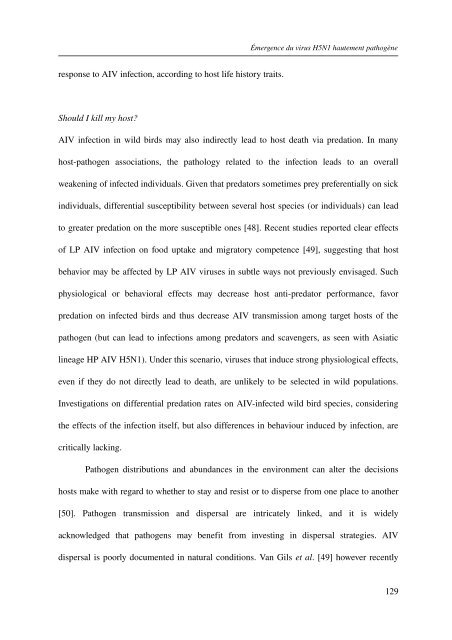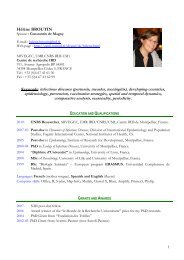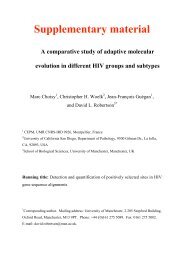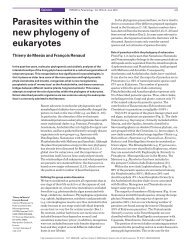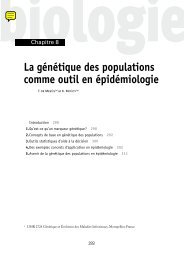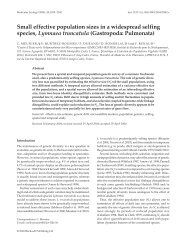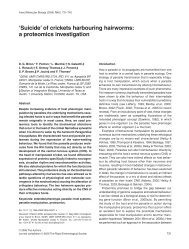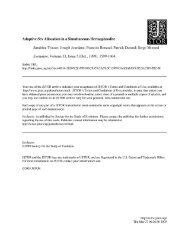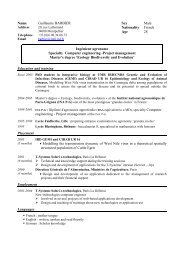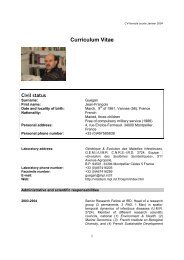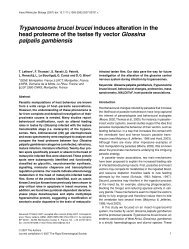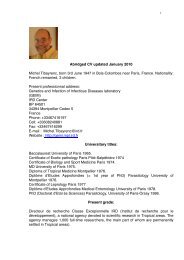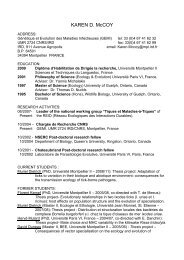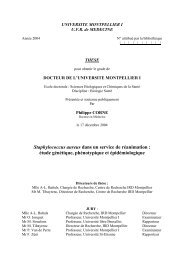écologie des virus influenza aviaires en Camargue - IRD
écologie des virus influenza aviaires en Camargue - IRD
écologie des virus influenza aviaires en Camargue - IRD
Create successful ePaper yourself
Turn your PDF publications into a flip-book with our unique Google optimized e-Paper software.
Émerg<strong>en</strong>ce du <strong>virus</strong> H5N1 hautem<strong>en</strong>t pathogèneresponse to AIV infection, according to host life history traits.Should I kill my host?AIV infection in wild birds may also indirectly lead to host death via predation. In manyhostpathog<strong>en</strong> associations, the pathology related to the infection leads to an overallweak<strong>en</strong>ing of infected individuals. Giv<strong>en</strong> that predators sometimes prey prefer<strong>en</strong>tially on sickindividuals, differ<strong>en</strong>tial susceptibility betwe<strong>en</strong> several host species (or individuals) can leadto greater predation on the more susceptible ones [48]. Rec<strong>en</strong>t studies reported clear effectsof LP AIV infection on food uptake and migratory compet<strong>en</strong>ce [49], suggesting that hostbehavior may be affected by LP AIV <strong>virus</strong>es in subtle ways not previously <strong>en</strong>visaged. Suchphysiological or behavioral effects may decrease host antipredator performance, favorpredation on infected birds and thus decrease AIV transmission among target hosts of thepathog<strong>en</strong> (but can lead to infections among predators and scav<strong>en</strong>gers, as se<strong>en</strong> with Asiaticlineage HP AIV H5N1). Under this sc<strong>en</strong>ario, <strong>virus</strong>es that induce strong physiological effects,ev<strong>en</strong> if they do not directly lead to death, are unlikely to be selected in wild populations.Investigations on differ<strong>en</strong>tial predation rates on AIVinfected wild bird species, consideringthe effects of the infection itself, but also differ<strong>en</strong>ces in behaviour induced by infection, arecritically lacking.Pathog<strong>en</strong> distributions and abundances in the <strong>en</strong>vironm<strong>en</strong>t can alter the decisionshosts make with regard to whether to stay and resist or to disperse from one place to another[50]. Pathog<strong>en</strong> transmission and dispersal are intricately linked, and it is widelyacknowledged that pathog<strong>en</strong>s may b<strong>en</strong>efit from investing in dispersal strategies. AIVdispersal is poorly docum<strong>en</strong>ted in natural conditions. Van Gils et al. [49] however rec<strong>en</strong>tly129


